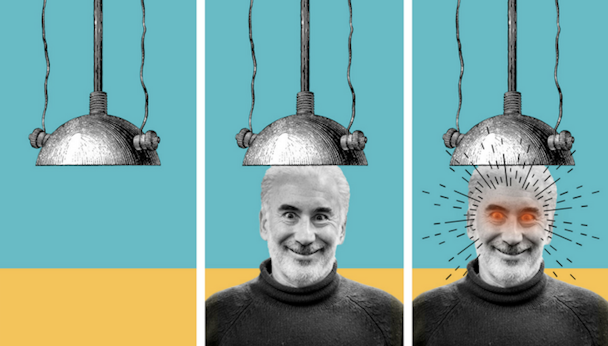Indie Influence: Cleveland agency’s ‘Sparkinator’ app helps jumpstart the creative process
Welcome to Indie Influence, a series that spotlights the work, perspectives and inspirations behind independent agencies across the country. This week we're featuring Cleveland-based Marcus Thomas's Sparkinator, an app created by one of the agency's creative directors that's designed to spark ideas and new thoughts.

Jim Sollisch, creative director and creator of Sparkinator
Brainstorming original and innovative ideas can be a difficult task for even the most creative types, which explains why a quick Google search of the words “brainstorming techniques” brings up a bevy of articles, listicles and blog posts that aim to explain how to get out of an idea rut.
To battle the brainstorm blues, Cleveland-based agency Marcus Thomas recently decided to take the matter into its own hands via the creation of the Sparkinator, a “choose-your-own-adventure” style app that presents users with off-the-wall prompts and techniques to help them jumpstart the creative process.
The app is the brainchild of Jim Sollisch, creative director at Marcus Thomas. Sollisch said he’s been collecting interesting creative thinking techniques for years, but it wasn’t until about a year ago that he partnered with one of the agency’s developers to put them all in an app for employees to use as a creative resource when brainstorming ideas for client work.
Here’s how it works: users who open the app are prompted to choose from 20 different techniques, some of which are ‘Think inside the box,’ ‘Find a villain’ and ‘Make the problem harder.’ Once chosen, a blurb pops up that explains what exactly that particular prompt means — for example, ‘’Make the problem harder’ asks creatives to “reframe the assignment as a problem, then make that problem harder.”
Users are then asked to click the ‘Start Timer’ button once they’ve settled on a technique, which runs for 10 minutes before prompting the user to choose another.
Sollisch said the point of the app is to help creatives get outside of their normal thinking patterns so that they can think about problems in new and fresh ways, something that he thinks doesn't come naturally to people since he believes humans are “efficiency experts.”
“Once you solve a problem and you hit a home run with something, you keep going down that path,” he said. “What if we could get all our creatives to share paths and have each of us be able to take 15 paths when we look at problem solving? That’s really the genesis of it - to collect these successful paths that others have taken, and force ourselves to go through an exercise where we at least consider those paths.”
Sollisch said that the agency has utilized many of these “paths” to come up with innovative campaigns for clients in recent years. For example, it used ‘Find a villain’ thinking - which prompts creatives to “create conflict and tension” between a brand and an unlikely adversary - to come up with a campaign for Nestle-owned Libby’s Pumpkin, a canned pumpkin brand. The agency was tasked with helping the brand sell more of its canned pumpkin outside of the holiday season, so it created a campaign that positioned pumpkin as the ultimate superfood to rival the likes of kale, salmon and quinoa.
“We found an enemy that wasn’t the most obvious enemy,” said Sollisch. “We decided to aim at superfoods, and we literally started a little trash talking war. We created 100 pieces of content that just bashed other superfoods. It turns out that pumpkin is really good in savory dishes to help add fiber and vitamin C, and it’s also good in sweet dishes. The other superfoods seem to go one way or the other.”
Another technique Marcus Thomas recently utilized is ‘Upside Down’ thinking, which Sollisch said essentially tasks creatives with “thinking 180 degrees away from the problem.” When coming up with a campaign idea for organ donation nonprofit Lifeblanc, the agency started thinking about all of the different ways that charities typically try to get people to donate or participate. Realizing that the category is overrun with 5K and 10K races, the agency decided to do the complete opposite: it organized a .01K race that asked “runners” to run all of 12 feet.
While Sollisch admits that some creatives at the agency embrace the app’s techniques more than others, he said about half of the creative department uses the Sparkinator on a regular basis. Sometimes, he and his fellow creative directors will push creatives to try a few of the app’s paths if it looks as though they’re in need of some inspiration or a nudge in the right direction.
“Part of creative direction is smelling out which paths might be good ones to go down,” he said. “We say, ‘try these three techniques as you’re approaching this.’”
Indie Influence is supported by Choozle, an independent digital advertising platform.

